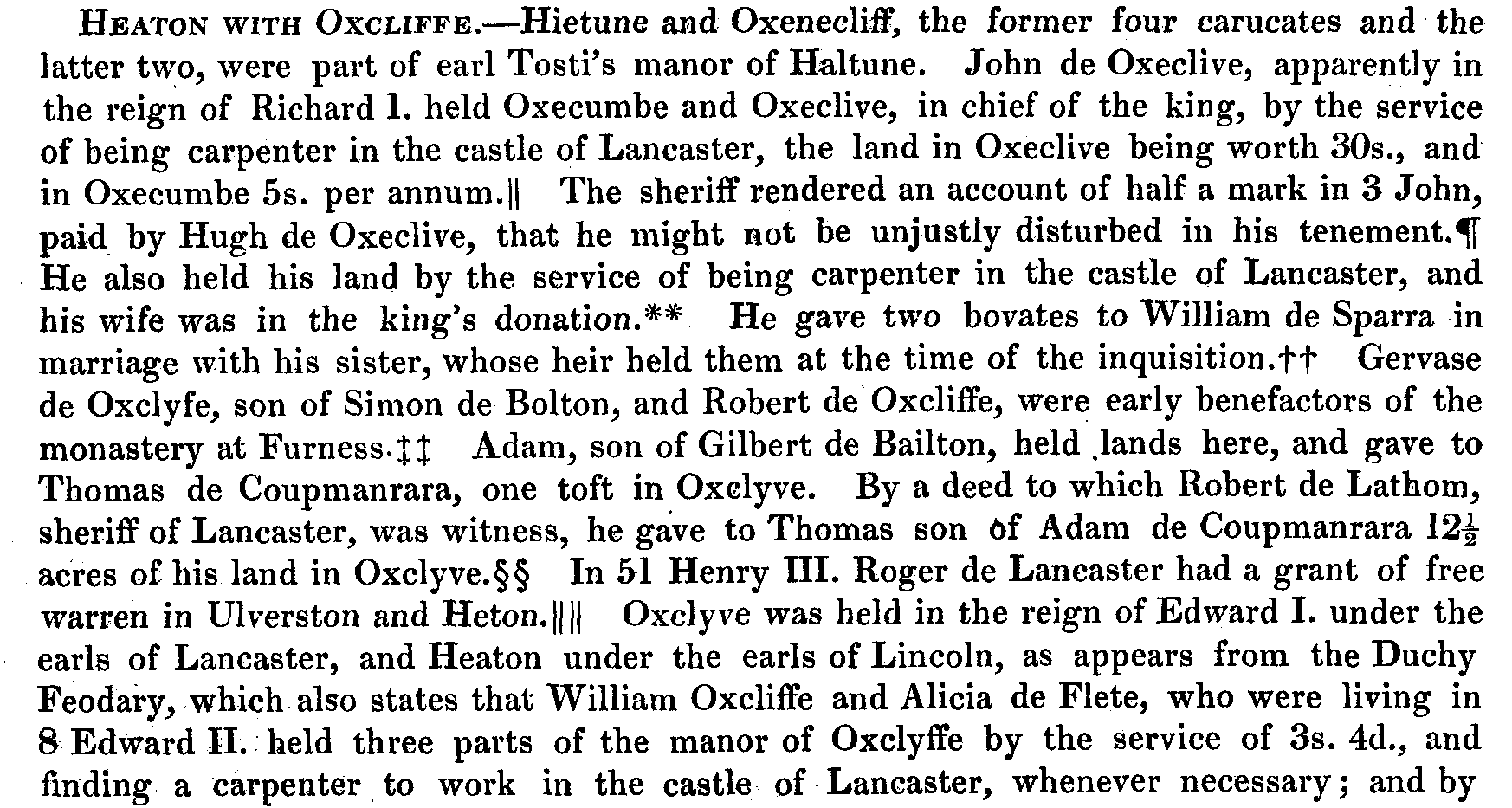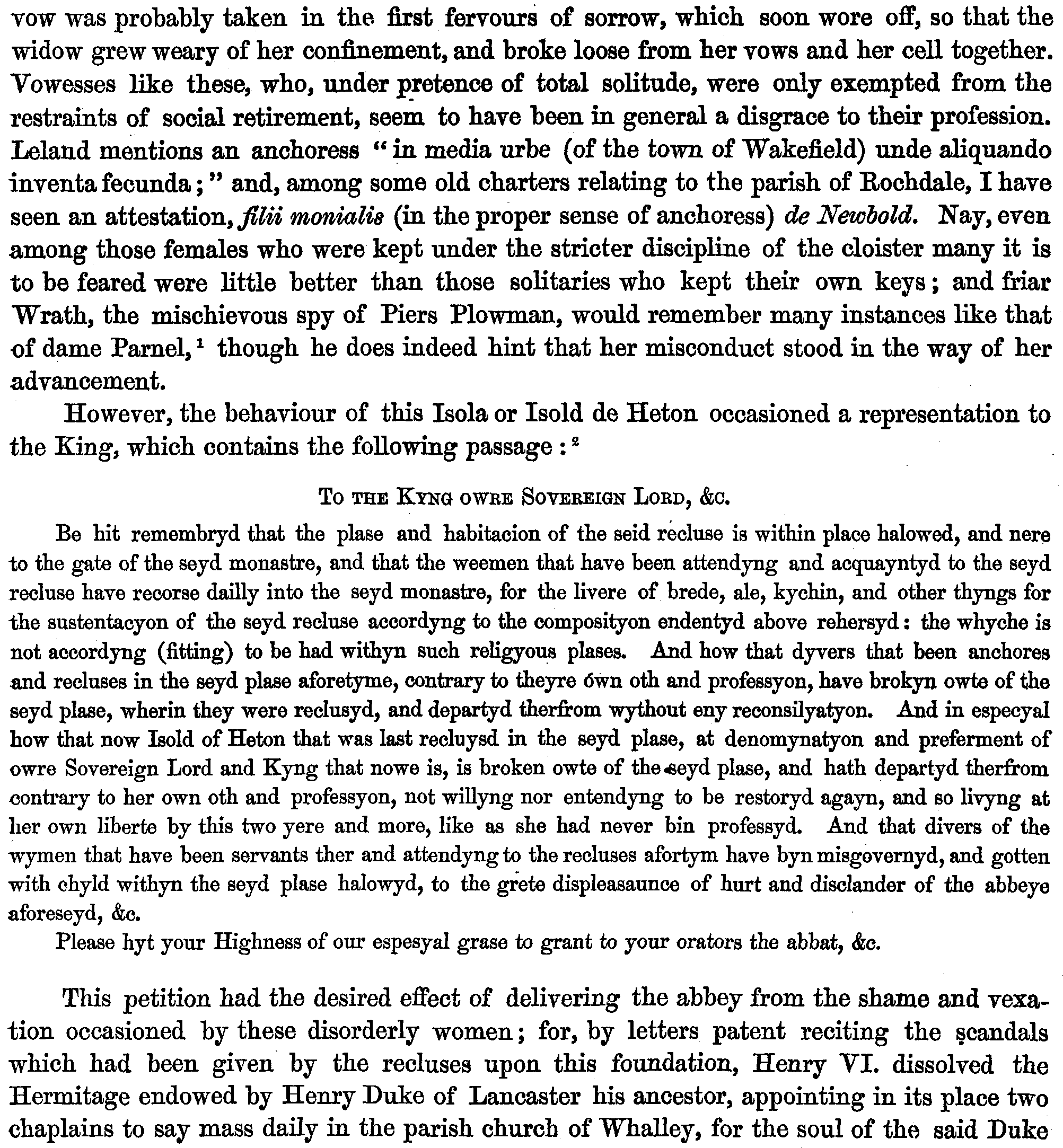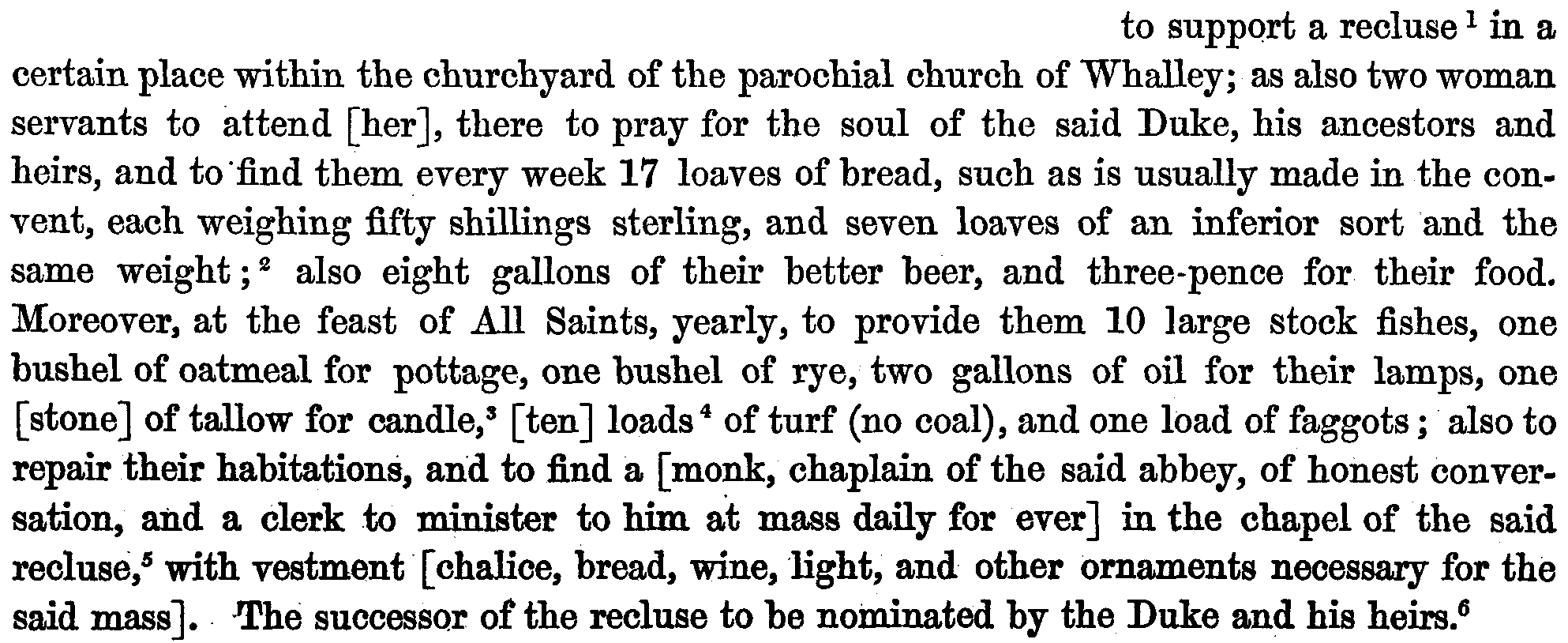



Catteralls and the Manor of Heton in Landisdale.
At some time in the early part of the 15th. century the Catteralls were possessed of the Manor of Heton (Heaton) in Landisdale (Lonsdale). Heton is a small village on the west bank of the river Lune, south of Lancaster and east of Heysham. Although the Lune is very strongly tidal in this area, the village of Heaton is on a low hill and is not subject to flooding (as some of the roads are just to the south, towards Sunderland point. It is not clear at what date the Catteralls became lords of the manor of Heton, and in the absence of evidence, it is simplest to suggest that this was probably a one-generation lordship acquired by marriage of a Catterall to a daughter and heiress of Heton. It is recorded in Baines, IV 473 that John de Catterall, who was living, and probably died, in 19 Henry VI, 1441, gave the manor of Heton in Landisdale (Lonsdale) to Roger de Brockholes, whose father John de Brockholes was living in Heton in 1402. This John de Catterall cannot be John, son of the first Richard who died 1419. John Catterall of Selby (living 14..) would not be described as 'de Catterall' nor would one of the Rathmell/Giggleswick branch of the family, or a descendant of the Lawrence Catterall who help Plumpton in 1327.) I have provisionally located him as (the son of) an unknown brother of the first Richard.
Of the three named in the grant of land in Catterall and Halcath by William II of Lancaster, Michael Athelstan, his wife Beatrice (Avice) and her step-brother Richard de Catterall, Roger, the son of Michael and Beatrice married Amabilla who was living 1336-8. Another Roger, son of Roger and Amabilla, was living in 1347, from whom descended John Ethelston and then another John de Ethelston described as de Ribleton and Brockholes. Both these Johns married daughters of the Fleetwood family who were possessed of Plumpton which had earlier belonged a generation earlier to Lawrence Catterall. Agnes fleetwood, wife of the second John, was living in 1428. I wonder if this John de Ethelston, of Ribleton and Brockholes, whose wife was living in 1428, could be the John de Brockholes, living in Heton in 1402, whose son Roger was the recipient of the manor of Heton from John de Catterall in 1441.
William de Heton granted land in Heton to Ra. de Ipre and Peter de Bohrun in 1378. Baines then says 'the lordship passed at a subsequent period to the Catterells'. The normal manner of transfer of a lordship was by marriage with a daughter and heiress - presumable a Catterall, perhaps John, to an heiress de Heton, perhaps Isold, see below.
There is a further link between the Catteralls and Heton when Richard de Caterall and Isabella de Eton are listed as paying a fine for a writ to the Duke of Lancaster in 1486. (A writ is the official document, issued in the king's name, confirming the transfer of property. The fine for the writ is the fee paid for the writ.) An aside: in the same records at Lancaster, for the year 1491, there is a fee paid for a writ for the 'Re-Disseizin as to the manors of ... Gosenargh ... and the 4th. part of Caterall and Wrightington Manors.'
The manor of Heton was still held by the Brockholes family; Thomas de Brockholes in 1567 in association with estates in Claughton. Extracts from Baines, .. edit., vol. IV, for Heton (p.538-9) and from Whitaker, History of Whalley, 4th. edit., vol II, Claughton (p.) follow.




(Note: there are two Claughtons in the area: Claughton (in Lonsdale, east of Lancaster), pronounced Clafton by locals. and Claughton near Catterall and Garstang, pronounced Cliton according to Whitaker. Although the Heton connection is in Lonsdale, the Claughton referred to is the one near Catterall. There are several other similar confusions possible - there is a Mytton near Catterall, which is not Mitton or Little Mitton near Whalley, there is a Rawcliffe Hall near Little Mitton, this is not the one near Catterall held by the Butlers of Rawcliffe.)

Isold de Heton, a widow, was appointed as recluse at Whalley by Henry VI under privy Seal on July 6 in the 15th. year of his reign (1437-8.)

On 3 feb. 3 Edward III (1329) John de Brockholes gave to Thomas Talbot, son of Edmund Talbot, all his lands and tenements in Bashall (History of Whalley, 4th. ed., II 497, footnote 4). This Thomas was the grandfather of the Thomas Talbot who married Isabella Catterall of Halton, and who made "mon treschere Pierre Aleyn de Catterall mon Generall Attorney pur apprendre, rendre, metter et respiter en mon nom put touz mes terres" in 3 Richard II (1378-9) (Harl. MS 804, folio 17). Relations between Thomas and his 'trescher Pierre' may well have deteriorated over time, for in 11 Henry IV (1409-10) Alan de Caterall, and Isabel his wife, by fine acknowledged that the manor of Bakesholfe (Bashall) belonged to Thomas Talbot, Kt (folio 16). Apparently Alan had some cause to believe that passing the manor of Halton to Thomas somehow entailed an equivalent right for himself in the manor of Bashall! So we have clear evidence for close family connections between Catteralls, Brockholes, Hetons, and Talbots at this period. There remains one further 'connection or co-incidence', the presence of Isold de Heton as anchorite in the hermitage attached to the Parish of Whalley and the Abbey nearby. The appointment of the position of anchorite was in the gift of the king, and Isold would not get it without some influence in the region of Whalley. Her appointment at Whalley coincided very closely with the transfer of the manor of Heton from John de Catterall to Roger de Brockholes (see below for chronology.) It is also known that Isold entered the hermitage after becoming a widow.
It seems very possible that Isold de Heton had married a younger son, John, of the Catteralls of Catterall and Little Mitton, endowing him for (at least) life with the manor of Heton, That John de Catterall arranged for the transfer of the Heton manor to his (distant) relation Roger de Brockholes on his death. On the death of John, or before if he was suffering from a terminal illness, Isold used her influence with her close relatives at Mitton, one of whom was a monk at the Abbey, to get the position of recluse at Whalley.
The abbot John Eccles petitioned Henry VI to close the Hermitage at Whalley because of misbehaviour by the anchorites, specifically naming Isold de Heton as having broken her vows and living outside the hermitage 'this two yere and more'. This dates the petition to 1440-1. Eccles died 1443-4. Whitaker supposes the




Whitaker also records a local Whalley legend about Isold; that she broke a leg on Whalley Nab trying to escape the attentions of monks from the abbey.
The position of recluse was well worth having, she had home, food (including 24 loaves of bread and eight gallons of beer a week), a weekly cash allowance, and two servants to look after her. Recluses like these were only subject to the restraints of social retirement.


There is little problem with dates:
1437-8 Privy Seal appointing Isold recluse at Whalley by Hen VI.
1440-3 Petition to dissolve the hermitage at Whalley quoting Isold breaking her vows 'two yeres or more' ago. This must have occurred after 1440.
At some date after 1440 and before 1443, the death of abbot Eccles who presented the petition.
1441 Final transfer of the manor of Heton from John de Catterall to Roger de Brockholes
1443-4 Death of abbot John Eccles.
We might very reasonably expect at least one year to elapse between the appointment of Isold and her taking up the position, we might also expect a delay of at least a year in the effective transfer of the manor of Heton in Landisdale to Roger de Brockholes. So:
1437-41 death of John de Catterall, followed by his widow, Isold de Heton entering the Hermitage at Whalley.
Clearly Isold's committment to her vows was low enough to allow her to break them after little more than 2 years.
The closing the hermitage at Whalley can be seen in two very different lights:
1. The disrepute brought upon the abbey by the behavior of Isold was purged. Or
2. The financial support dedicated to the Hermitage by William of Lancaster was transferred to the benefit of the abbey.
Not neccessarily an exclusive 'or'.
One result at least was that Isold earned for herself a place in the legends of Whalley, and a place in English literature.
Local legend has it that Isold broke her leg on Whalley Nab while escaping the attentions of the monks of Whalley Abbey.
Harrison Ainsworth in "The Lancashire Witches" uses her as a recurrring malevolent ghost resolved to corrupt the innocent Alizon Device.
Alizon Device, a teenager, was hanged as a witch in 1612. Before her trial at Lancaster, she confessed and repented of bewitching one John Law, a pedlar from Halifax, at Roughlee in Pendle near Whalley. The description of John Law's death looks remarkably like a major stroke. The historical problem associated with the Lancashire Witches, is how it came about that Alice Nutter, a prominent local landowner, came to be included among the witches. Socially any association between Alice Nutter and the Demdike family was extremely unlikely - even Alice Nutter's servants would not have be seen speaking to the Demdikes. However, Alice Nutter was involved in a boundary dispute with Roger Nowell of Read, who brought the witches to trial (and a boundary dispute with Sir Roger clearly defines her high social position in the area.) Alice Nutter was a known recusant, adhering to the old religion, whilst Sir Roger was committed to the new protestant church. Another view expressed is that Roger Nowell was completely irreligious, but probably a different Roger Nowell.
Certainly the Nutters were not just ordinary practising catholics: within Alice Nutter's lifetime she had had seen two of her close kinsmen repeatedly imprisoned, banished abruad and finally executed (hung, drawn and quartered) for the crime of being a catholic priest and saying mass in England. John and Robert Nutter, were both of New Laund near Roughlee. John was educated at St. John's College, Cambridge and then entered Douay University at Rheims in 1577 (there was an English Catholic College at Douay, founded by another Lancashire man, Allen, which was a common place for English religious exiles during the period 1578-1593). Exild to Douay along with John Nutter was another Burnley man, Robert Woodruff. Nutter and Woodruff left Douay for England again in 1582, but were ship-wrecked on the way. Rescued, Nutter was found to have in his possession a box containing Roman Catholic catechisms, and he was imprisoned in Marshalsea. He and other priests were found guilty of treason on February 7th., 1584 and were executed.
Robert Nutter entered Brazenose College, Osford in 1564, was exiled to Douay, Rheims where he was ordained, and returned to England in 1581. For the next 20 years he was in and out of prison. After two years administering the faith, he was caught and imprisoned in the Tower of London where he was tortured on two occasions., finally being sent back to France on january 21st., 1585. later that year he returned to England again using the name of Rowley (Roughlee) He was captured again after a few months and imprisoned first at newgate, then at Marshalsea where he was described as "Nutter alias Rowley, a seminary priest, a very perilous man, and desperate to attempt any mischief, and therefore to be specially watched." Nevertheless he escaped again in 1590 and reached Lancashire where he continued to administer the faith for another 10 years before he was again capures in may 1600. he was executed at Lancaster castle on July 26th., 1600.
With recent antecedents like this it is not surprising that all the Nutter family, including Alice, were devout catholics. With one successful law suit against the protestant magistrate, Roger Nowell, and another boundary dispute against him pending, some antagonism between Nowell and Nutter might be expected.
The immediate cause of the case against the Pendle witches was the death of John law, described as a pedlar, after Alizon device had been refused when begging from him. Law's father is recorded as travelling from Halifax to see his paralysed son before his death. A John Law from Halifax had earlier been indited as a travelling (and illegal) Catholic priest, carrying the mass to those upholding the old religion.
Nobody so far has cast any shadow of blame on Roger Nowell, who got his boundary dispute settled satisfactorily, and/or rid the countryside of an important renegade Catholic believer. A good plot: so get writing - and don't forget to work in Isold, or the marriage of Grace Catterall to Roger Nowell. (You might have to bend dates a little to make it work!)
Harrison Ainsworth makes Alice a true witch, but who by repenting at the end beats the devil. Robert Neil in 'Mist over Pendle' has her a murderess whom Sir Roger cannot find evidence to convict - so he frames her as a witch along with the Demdikes.